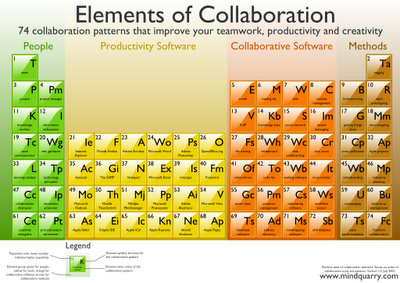Alexander Richter schreibt im Neubiberg-Blog über eine IBM Veranstaltung zum Thema Web 2.0 im Unternehmen, einige interessante Stellen:
Peter Schütt (IBM) [ist] beunruhigt, wie wenig die deutschen Unternehmen von den (durch Web 2.0 etc.) gebotenen Möglichkeiten zur Zusammenarbeit Gebrauch machen. Er sieht dadurch auch den Standort Deutschland gefährdet bzw. in jedem Fall hinterherhinken.
und
[…] wie die IBM das Web 2.0 aufteilt:
1. das Web 2.0 im privaten, öffentlichen Bereich,
2. das Web 2.0 im öffentlichen Bereich von Unternehmen (oft über die Communications-Abteilungen gesteuert)
3. und das Web 2.0 im sicheren, organisationsinternen Bereich
Gefällt mir. Im Blog selbst habe ich noch einen ausführlichen Kommentar zum Thema bottom-up vs. top-down als Erfolgsmodelle der Implementierung geschrieben, zur Dokumentation hier der wichtigste Teil:
Gerade bei Social Software ist eine gewisse Freiheit und Adaptivität der Entwicklung, aber auch der Nutzung, eine Voraussetzung für die Nachhaltigkeit, Innovativität und Effektivität der Lösungen. Gerade bei Social Software ist eine gewisse Freiheit und Adaptivität der Entwicklung, aber auch der Nutzung, eine Voraussetzung für die Nachhaltigkeit, Innovativität und Effektivität der Lösungen. Die häufig anzutreffende ablehnende bzw. sehr kritische Haltung gegenüber bottom-up Prozessen ist dabei aus meiner Sicht u.a. das Resultat von verschiedenen Ängsten, die zum Teil unbegründet sind (u.a. Ängste aus Unwissenheit, Fehlinfomationen, Vorurteilen), zum Teil aber auch “Hand und Fuß haben” (bspw. lässt sich schon ein gewisser Kontrollverlust bzw. eine geänderte Rolle von FK beobachten, nicht jede(r) geht souverän damit um bzw. kann seine Rolle neu interpretieren).
Gleichzeitig ist top-down Unterstützung und Rückhalt extrem wichtig, nicht zuletzt um (politische) Hindernisse bei der Implementierung zu überwinden – ideal wäre es immer wenn sowohl top-down als auch bottom-up abgestimmt agiert würde (und wenn das Middle Management eine übersetzende, kommunizierende Rolle einnehmen würde). Diese ideale Welt ist leider nicht die Regel, umso wichtiger wird es aber sein Unternehmensleitungen und Middle Management für die Vorteile von Social Software zu interessieren und “ins Boot zu holen”.


